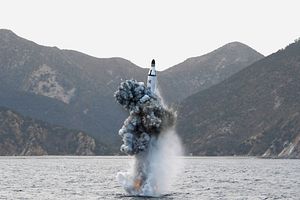U.S. military intelligence has detected a new diesel-electric submarine under construction at North Korea’s Sinpo shipyard, on the country’s east coast, according to a U.S. government source with knowledge of North Korea’s weapons programs who spoke to The Diplomat.
According to current U.S. intelligence estimates, the submarine’s submerged displacement is thought to be in excess of 2,000 tons with a beam measurement of 11 meters. The vessel is likely the largest ever to be built for the Korean People’s Navy since the Najin-class frigates.
The submarine, dubbed the Sinpo-C by the United States intelligence community, is likely a successor to North Korea’s Gorae-class ballistic missile submarine (SSB). (The U.S. intelligence community calls the Gorae-class the Sinpo-B.) Open source analysis, including by analysts at 38 North, had also detected signatures of ongoing shipbuilding at Sinpo suggestive of a new submarine.
North Korea has a single Gorae-class submarine in its inventory. The submarine has not entered operational use and is the only North Korean submarine capable of launching the KN11/Pukguksong-1 submarine-launched ballistic missile (SLBM). U.S. intelligence assesses the submarine’s submerged displacement to be approximately 2,000 tons.
The Gorae-class submarine has seen improvements as recently as this year. Early in the summer, the submarine was fitted with a new launch tube, The Diplomat has learned.
It is unknown if the launch tube is meant to accommodate the extant Pukguksong-1 SLBM or whether the Gorae-class may soon operate a newer SLBM that may require a redesigned launch tube, with the Pukguksong-1 potentially retired for a newer missile.
North Korea released potential evidence in late-August of a new solid-fuel SLBM, the Pukguksong-3, though the existence of this missile remains unconfirmed by U.S. intelligence.
A new North Korean SLBM may feature an advanced airframe using lighter composite materials that could lead to it exhibiting a considerably greater total range than the first-generation Pukguksong-1.
This summer, North Korea carried out repeated SLBM ejection tests at its test stand near the Sinpo shipyard where the Gorae-class is ported and where the Sinpo-C submarine is under construction.
U.S. intelligence recorded ejection tests on May 30, July 18, July 25, and July 30. No ejection new tests have taken place at Sinpo since July. Ejection tests allow North Korean engineers to verify the operation of the missile’s cold-launch system, which pushes the missile through the sea’s surface before its engines ignite.
Prior to North Korea’s second ICBM test in July, U.S. intelligence had assessed that a new SLBM flight test was likely. This assessment was revised downward in August following North Korea’s second ICBM test in late-July. As of early October, an SLBM flight test was not seen as imminent by U.S. intelligence.
In September, Japan’s Asahi Shimbun reported that North Korea had carried out a failed test of a new solid-fuel engine for an SLBM at Sinpo as well. The test reportedly resulted in an explosion that killed at least one person, according to the Asahi‘s report. The Diplomat was unable to independently confirm that such a test took place at Sinpo.
The construction of a second ballistic missile submarine at Sinpo suggests that North Korea is planning on potentially operationalizing a sea-based deterrent capability around multiple submarines in the coming years.
A single Gorae-class would likely lack sufficient survivability in a conflict, especially given that the submarine’s location at port is well-known in peacetime. (Open source analysis regularly observes the Gorae in port at Sinpo.)
North Korea last carried out an SLBM flight test in August 2016. In that test, a Pukguksong-1 SLBM flew to 500 kilometers on a lofted trajectory and splashed down in the Sea of Japan.
Correction: An earlier version of this piece stated the Gorae‘s submerged displacement estimate as 1,700 tons.

































